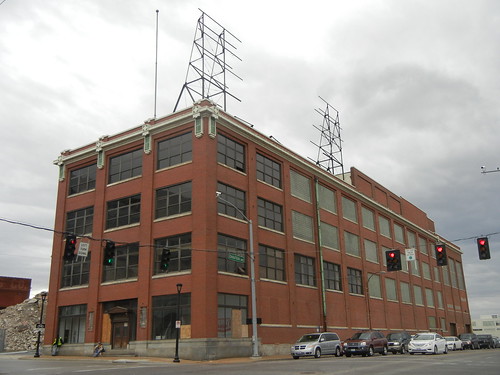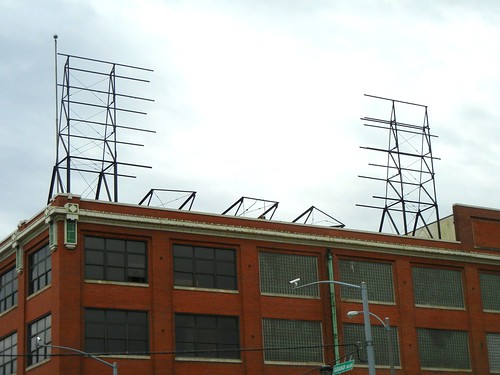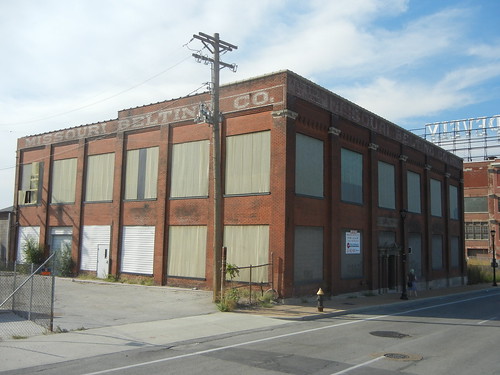by Michael R. Allen

Perhaps right now the Pevely Dairy Plant office building at the southwest corner of Grand and Chouteau seems like the back half of the Titanic, shorn from the rest of the ship and poised to sink out of sight. On October 9, the city watched a distress call when the “P” from the neon sign on the roof fell crashing to the ground. Quickly wreckers from Ahrens Contracting removed the center of the sign and all of the letters, leaving the sign looking punched out. The west side sports a mangled hole, and the rest of the site is covered in rubble. Pevely’s death warrant already was signed by the city’s Planning Commission, which offered a Kevorkian comfort in its stipulation that the National Register of Historic Places-listed corner building could not fall until owner St. Louis University had obtained a permit to construct a supposedly equally meritorious new ambulatory care center.
As David Byrne sang, the whole thing is over. Right? Not really. The Pevely building is in fine shape for rehabilitation as it is – perhaps better than before. Here are the reasons why the fate of the Pevely building should not be seen as a certainty.

The building remains structurally sound. Demolition activity at the Pevely plant has claimed the milk plant, the garage and some additions. The smokestack, once embraced for preservation by architects at the Lawrence Group working for St. Louis University, came down too. The 1915 office building, designed by Leonhard Haeger, and a three-bay 1927 addition to the west are all that remains, per the decision of the Planning Commission. Yet Ahrens’ expert surgery leaves the remaining section uncompromised. The building makes use of a reinforced concrete structural system based on the “Kahn system†(developed by Julius Kahn for the great early factories of Detroit’s auto industry): a modular grid of columns, caps and reinforced slabs. This system is easy to alter or expand as well.
St. Louis University might not build the ambulatory care center on the site after all. The university claims that it will build the center that it presented to the Preservation Board and the Planning Commission, yet rumors suggest the project is not certain. At this time, the university has not applied for a building permit. There are site control issues corresponding to the historic Missouri Belting Company Building (built in 1911, designed by Otto Wilhelmi) to the south, which is privately owned. Meanwhile, the university has a large, cleared fully-controlled site just north of Chouteau Avenue that would offer an even more visible symbol of the university’s medical center to I-64/US-40 motorists and MetroLink riders.

If the university builds the ambulatory care center on another site, it won’t get to demolish the corner building. Should the university elect to build the center elsewhere, then the city Building Commissioner will have to deny any application for demolition. The Planning Commission decision is very specific that the only condition for issuance of a demolition permit is the issuance for a construction permit for the ambulatory care center as presented to the Planning Commission. Steve Smith of the Lawrence Group presented a plan with a specific site plan and specific exterior appearance. While the renderings were vague, the site plan was not. The city will enforce that plan. Since the Preservation Board evaluated each demolition permit separately, the remaining Pevely is still a building and not a fragment to city officials. A new application for demolition would return to the Cultural Resources Office and possibly to the Preservation Board, and would be evaluated using the criteria of the city’s preservation ordinance.

The building is still eligible for historic rehabilitation tax credits. Yes, the entire complex of buildings was listed in the National Register of Historic Places. Yet the nomination counts the component buildings as separate resources, making the office building and its addition a separate building that is still possessing sufficient integrity to be eligible for state and federal historic tax credits. The building historically had only three visible elevations, on the two streets and on the south. These elevations are largely unchanged. The nomination barely addressed the sign, which was installed in 1943. Likely the preparer was leaving its fate open-ended. Hence, the absence of the sign does not pose any threat to getting historic tax credits. The building is ready to receive them, and stands apart from less attractive and less well laid-out buildings.

There still are human-scaled urban buildings at an intersection desperately needing a sense of character. The Pevely office building, with its functional grid clad in beloved red brick, and the perfectly-scaled Missouri Belting Company Building – St. Louisans love two-story mixed-use buildings! — offer a good starter for remaking part of the intersection. (For now, the Captain D’s sea shanty on the northeast corner is at least approachable on foot; that can be dealt with later.) Grand and Chouteau has become engulfed with open space, eroding its sense of urbanity even as flying saucers are being preserved across the viaduct. Yet the intersection retains two historic buildings and plenty of open space for new construction. The university can resituate the ambulatory care center and embrace these existing buildings, which now occupy a site extremely flexible for residential, retail, commercial or other uses. The medical center is bereft of apartments and condominiums for its students and staff, yet it has a base of thousands of people. Retention of these buildings and construction of new housing would make the St. Louis University Medical Center competitive with the Washington University Medical Center and would smartly build upon the MetroLink station just a walk to the north.

St. Louis University is in the midst of revolution. Something is happening at the university, albeit on an unpredictable course. The Faculty Senate vote of no confidence in the leadership of President Lawrence Biondi comes amid growing dissatisfaction about the direction of the university. The Pevely decision is one of the recent events that has cast Biondi and the administration in a negative light, and put the school at odds with people who should be supporting the growth of a university that has preserved many historic buildings at its Midtown campus. Would a reversal ease tensions?

Some may have trouble imagining the Pevely Dairy building rehabilitated into the symbol of a new era of St. Louis University, but to this author it makes sense. The university ought to consider reversing its course on the remaining Pevely Dairy Plant building, and seeking to find a new life for it that honors both the city’s history and vision of the university for its future. A renovated Pevely building and a new ambulatory care center, side by side – that vision is still possible and still the best plan for the city.

10 replies on “Signless and Separated, Pevely Dairy Building Still Reusable — and SLU Can Still Be the Hero”
All said and done, the mighty Vatican is the power behind Biondi’s throne. SLU is the second most prominent Catholic university in the United States, behind Georgetown. The United States is usually the largest annual donor in the Vatican portfolio, tied with Germany. Hence, the Vatican has a keen interest in the headlines coming out of SLU.
Just guessing that faculty revolt and a stream of negative headlines would not be part of Vatican fundraising protocol. If anyone understands the likely trajectory of powerful men, it’s Vatican cardinals.
A change is probably in the works.
” (For now, the Captain D’s sea shanty on the northeast corner is at least approachable on foot; that can be dealt with later.) ”
Why do you call this a shanty? It’s a legitimate business that affords people employment, and you make it sound like a dump.
Come on, now. He’s only commenting on the building itself, not the legitimacy of the business that occupies it. Captain D’s could equally well occupy a storefront in a multi-story mixed-use building on the same site, and they would likely enjoy more business due to the increased density.
Think “sea shanty” again, except this time with tongue firmly implanted in cheek.
The sign coming down certainly seems suspicious. I had given SLU and Biondi some of the benefit of the doubt, but am quickly beginning to feel that they have not been acting in good faith in their dealings.
I was not trying to insinuate anything about the business. I was pointing out that the building is not urban in form.
Do you think that a consultant hired by the board of trustees is enough to fend off the Vatican?
It is a major building in any case. Quite a presence on that corner. Beautiful proportions as it sits. Quite an historic building in its own right, but speaks to a walking, transit friendly we need to bring back.
No matter how much SLU changes course, the city government is absolutely.at fault here. How can city government neglect to protect transit priorities? The multimillion dollar investments in light rail and converting the Grand Ave bridge into a pedestrian friendly walk way are wasted investments if the surrounding city plan does not support this investment.
We have yet to see a proposal that capitalizes (there is that word again) on the pedestrian/transit potential of the sites surrounding the Grand Ave light rail station.
Notre Dame, Boston College, Fordham, Georgetown, Loyola Chicago, Loyola Maramount, Marquette, Santa Clara, Villanova are all probably better than SLU.
Vatican conspiracy seems to be stretching it.
Funny thing is, at least some of the letters are still on top of the building. Driving northbound on Grand you can see the red Y sticking up. It looks like they just severed the steel out of the middle of the sign and laid it back. So much for preserving the sign, it sitting up there to get destroyed and tossed away at a later date.